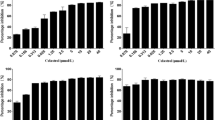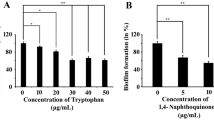Abstract
Antimicrobial resistance is a natural phenomenon and is becoming a huge global public health problem, since some microorganisms not respond to the treatment of several classes of antibiotics. The objective of the present study was to evaluate the antibacterial, antibiofilm, and synergistic effect of triterpene 3β,6β,16β-trihydroxyilup-20(29)-ene (CLF1) against Staphylococcus aureus and Staphylococcus epidermidis strains. Bacterial susceptibility to CLF1 was evaluated by minimum inhibitory concentration (MIC) and the minimum bactericidal concentration (MBC) assay. In addition, the effect combined with antibiotics (ampicillin and tetracycline) was verified by the checkerboard method. The biofilms susceptibility was assessed by enumeration of colony-forming units (CFUs) and quantification of total biomass by crystal violet staining. The compound showed bacteriostatic and bactericidal activity against all Staphylococcal strains tested. The synergistic effect with ampicillin was observed only for S. epidermidis strains. Moreover, CLF1 significantly inhibited the biofilm formation and disrupted preformed biofilm of the all strains. Scanning electron microscopy (SEM) images showed changes in the cell morphology and structure of S. aureus ATCC 700698 biofilms (a methicillin-resistant S. aureus strain). Molecular docking simulations showed that CLF1 has a more favorable interaction energy than the antibiotic ampicillin on penicillin-binding protein (PBP) 2a of MRSA, coupled in different regions of the protein. Based on the results obtained, CLF1 proved to be a promising antimicrobial compound against Staphylococcus biofilms.





Similar content being viewed by others
Data Availability
All data and material are available with corresponding author.
Code Availability
Not applicable.
References
Wensley S (2016) BVA welcomes call for global action on AMR. Vet Rec 178:545–545. https://doi.org/10.1136/vr.i2971
Jenkins DR (2017) Nosocomial infections and infection control. Medicine (UK) 45:629–633. https://doi.org/10.1016/j.mpmed.2017.07.005
Jamal M, Ahmad W, Andleeb S, Jalil F, Imran M, Nawaz MA, Hussain T, Ali M, Rafiq M, Kamil MA (2018) Bacterial biofilm and associated infections. J Chin Med Assoc 81:7–11. https://doi.org/10.1016/j.jcma.2017.07.012
Sulistyani H, Fujita M, Miyakawa H, Nakazawa F (2016) Effect of roselle calyx extract on in vitro viability and biofilm formation ability of oral pathogenic bacteria. Asian Pac J Trop Med 9:119–124. https://doi.org/10.1016/j.apjtm.2016.01.020
Koo H, Allan NH, Howlin RP, Stoodley P, Hall-Stoodley L (2017) Targeting microbial biofilms: current and prospective therapeutic strategies. Nat Rev Microbiol 15:740–755. https://doi.org/10.1038/nrmicro.2017.99
O’Neill J (2016) Nature Rev Drug Discov 15:526. https://doi.org/10.1038/nrd.2016.160
Vuuren SV, Holl D (2017) Antimicrobial natural product research: a review from a South African perspective for the years 2009–2016. J Ethnopharmacol 17:236–252. https://doi.org/10.1016/j.jep.2017.07.011
Katerere DR, Gray AI, Nash RJ, Waigh RD (2003) Antimicrobial activity of pentacyclic triterpenes isolated from African Combretaceae. Phytochemistry 63:81–88. https://doi.org/10.1016/j.jep.2017.07.011
Lira SRD, Almeida RN, Almeida FRC, Oliveira FS, Duarte JC (2008) Preliminary studies on the analgesic properties of the ethanol extract of Combretum leprosum. Pharm Biol 40:213–215. https://doi.org/10.1076/phbi.40.3.213.5837
Nunes PHM, Cavalcanti PMS, Galvao SMP, Martins MCC (2009) Antiulcerogenic activity of Combretum leprosum. Pharmazie 64:58–62. https://doi.org/10.1691/ph.2008.8652
Facundo VA, Andrade CHS, Silveira ER, Braz-Filho R (1993) Triterpenes and flavonoids from Combretum leprosum. Phytochemistry 32:411–415. https://doi.org/10.1016/S0031-9422(00)95005-2
Pietrovski EF, Rosa KA, Facundo VA, Rios K, Marques MCA, Santos ARS (2006) Antinociceptive properties of the ethanolic extract and of the triterpene 3β,6β,16β -trihidroxilup-20(29)-ene obtained from the flowers of Combretum leprosum in mice. Pharmacol Biochem Behav 83:90–99. https://doi.org/10.1016/j.pbb.2005.12.010
Viau CM, Moura DJ, Facundo VA, Saffi J (2014) The natural triterpene 3β,6β,16β-trihydroxy-lup-20 (29)-ene obtained from the flowers of Combretum leprosum induces apoptosis in MCF-7 breast cancer cells. BMC Complement Altern Med 14:1–12. https://doi.org/10.1186/1472-6882-14-280
Evaristo FFV, Albuquerque MRJR, Santos HS, Bandeira PN, Avila FN, Silva BR, Vasconcelos AZ, Rabelo EM, Nascimento-Neto LG, Arruda FVS et al (2014) Antimicrobial effect of the triterpene 3β,6β,16β-trihydroxylup-20(29)-ene on planktonic cells and biofilms from Gram positive and Gram negative bacteria. Biomed Res Int 2014:1–7. https://doi.org/10.1155/2014/729358
Evaristo FFV, Vasconcelos MA, Arruda FVA, Pereira AL, Andrade AL, Alencar AB, Nascimento MF, Sampaio AH, Sampaio SS, Bandeira PN et al (2017) Antibacterial effect on mature biofilms of oral streptococci and antioxidant activity of 3β,6β,16β-trihydroxylup-20(29)-ene from Combretum leprosum. Med Chem Res 26:3296–3306. https://doi.org/10.1007/s00044-017-2022-7
Teles CBG, Moreira-Dill LS, Silva AAA (2015) A lupane-triterpene isolated from Combretum leprosum Mart. fruit extracts that interferes with the intracellular development of Leishmania (L.) amazonensis in vitro. BMC Complement Altern Med 15:165. https://doi.org/10.1186/s12906-015-0681-9
Odds FC (2003) Synergy, antagonism, and what the chequerboard puts between them. J Antimicrob Chemother 52:1. https://doi.org/10.1093/jac/dkg301
Stepanovic S, Vukovic D, Dakic I, Savic B, Syabic-Vlahovic M (2000) A modified microtiter-plate test for quantification of staphylococcal biofilm formation. J Microbiol Methods 40:175–179. https://doi.org/10.1016/s0167-7012(00)00122-6
Vasconcelos MA, Arruda FVS, Alencar DB, Sampaio SS, Albuquerque MRJR, Santos HS, Bandeira PN, Pessoa ODL, Cavada BS, Henriques M, Pereira MO, Teixeira EH (2014) Antibacterial and antioxidant activities of derriobtusone A isolated from Lonchocarpus obtusus. Biomed Res Int 2014:1–9. https://doi.org/10.1155/2014/248656
Huey R, Morris GM, Forli S (2012) Using AutoDock 4 and AutoDock Vina with AutoDockTools: a tutorial. The Scripps Research Institute, California, 5 pp.
Trott O, Olson AJ (2010) AutoDock Vina: improving the speed and accuracy of docking with a new scoring function, efficient optimization, and multithreading. J Comput Chem 31:455–461. https://doi.org/10.1002/jcc.21334
Pettersen EF, Goddard TD, Huang CC, Couch GS, Greenblatt DM, Meng EC, Ferrin TE (2004) UCSF Chimera—a visualization system for exploratory research and analysis. J Comput Chem 25:1605–1612. https://doi.org/10.1002/jcc.20084
Hanwell MD, Curtis DE, Lonie DC, Vandermeersch T, Zurek E, Hutchison GR (2012) Avogadro: an advanced semantic chemical editor, visualization, and analysis platform. J Cheminform 4:1–17. https://doi.org/10.1186/1758-2946-4-17
Systèmes D (2016) BIOVIA Discovery Studio Dassault Systmes BIOVIA, Discovery Studio Modeling Environment. Dassault Syst.
Csizmadia P (2019). MarvinSketch and MarvinView: molecule applets for the World Wide Web.
Halgren TA (1996) Merck molecular force field. I. Basis, form, scope, parameterization, and performance of MMFF94. J Comput Chem 17:490–519. https://doi.org/10.1002/(SICI)1096-987X(199604)17:5/6%3c490::AID-JCC1%3e3.0.CO;2-P
Meza JC (2010) Steepest descent. Wiley Interdiscip Rev Comput Stat 2:719–722. https://doi.org/10.1002/wics.117
Da Silva WMB, de Oliveira PS, Alves DR, de Menezes JESA, Magalhães FEA, Silva FCOS, Silva J, Marinho ES, Morais SM (2020) Synthesis of quercetin-metal complexes, in vitro and in silico anticholinesterase and antioxidant evaluation, and in vivo toxicological and anxiolitic activities. Neurotox Res 37:893–903. https://doi.org/10.1007/s12640-019-00142-7
Mahasenan KV, Molina R, Bouley R, Batuecas M, Fisher JF, Hermoso JA, Chang M, Mobashery S (2017) Conformational dynamics in penicillin-binding protein 2a of methicillin-resistant Staphylococcus aureus, allosteric communication network and enablement of catalysis. J Am Chem Soc 139:2102–2110. https://doi.org/10.1021/jacs.6b12565
Marinho EM, de Andrade Neto JB, Silva J, Silva CR, Cavalcanti BC, Marinho ES, Júnior HVN (2020) Virtual screening based on molecular docking of possible inhibitors of Covid-19 main protease. Microb Pathog 148:104365. https://doi.org/10.1016/j.micpath.2020.104365
Shityakov S, Förster C (2014) In silico predictive model to determine vector-mediated transport properties for the blood-brain barrier choline transporter. Adv Appl Bioinform Chem 7:23–26. https://doi.org/10.2147/AABC.S63749
Cushnie TPT, Lamb AJ (2005) Antimicrobial activity of flavonoids. Int J Antimicrob Agents 26:343–356. https://doi.org/10.1016/j.ijantimicag.2005.09.002
Yusuf D, Davis AM, Kleywegt GJ, Schmitt S (2008) An alternative method for the evaluation of docking performance: RSR vs RMSD. J Chem Inf Model 48:1411–1422. https://doi.org/10.1021/ci800084x
Angeh JE, Huang X, Sattler I, Swan GE, Dashe H, Härtl A, Eloff JN (2007) Antimicrobial and anti-inflammatory activity of four known and one new triterpenoid from Combretum imberbe (Combretaceae). J Ethnopharmacol 1:56–60. https://doi.org/10.1016/j.jep.2006.09.002
Gossan DPA, Magid AA, Yao-Kouassi PA, Josse J, Gangloff SC, Morjani H, Voutquenne-Nazabadioko L (2016) Antibacterial and cytotoxic triterpenoids from the roots of Combretum racemosum. Fitoterapia 110:89–95. https://doi.org/10.1016/j.fitote.2016.03.002
Kurek A, Grudniak AM, Szwed M, Klicka A, SamLuk L, Wolska KI, Janiszowska W, Popowska M (2010) Oleanolic acid and ursolic acid affect peptidoglycan metabolism in Listeria monocytogenes. Antonie Van Leeuwenhoek 97:61–68. https://doi.org/10.1007/s10482-009-9388-6
Chung PY, Chung LY, Navaratnam P (2013) transcriptional profiles of the response of methicillin-resistant Staphylococcus aureus to pentacyclic triterpenoids. PLoS ONE 8(2):e56687. https://doi.org/10.1371/journal.pone.0056687
Wang CM, Chen HT, Wu ZY, Jhan YL, Shyu CL, Chou CH (2016) Antibacterial and synergistic activity of pentacyclic triterpenoids isolated from Alstonia scholaris. Molecules 21(139):1–11. https://doi.org/10.3390/molecules21020139
Kurek A, Nadkowska P, Pliszka S, Wolska KI (2012) Modulation of antibiotic resistance in bacterial pathogens by oleanolic acid and ursolic acid. Phytomedicine 19:515–519. https://doi.org/10.1016/j.phymed.2011.12.009
Cruz BG, Rodrigues Teixeira AM, Silva PTD, Vasconcelos Evaristo FF, de Vaconcelos MA, Holanda Teixeira E, Dos Santos HS, Bandeira PN, Sena-Júnior DM, Barreto VP, Coutinho HDM (2019) Antimicrobial activity of the lupane triterpene 3β,6β,16β-trihydroxylup-20(29)-ene isolated from Combretum leprosum Mart. J Med Microbiol 68(10):1438–1444. https://doi.org/10.1099/jmm.0.001056
Fishovitz J, Hermoso JA, Chang M, Mobashery S (2014) Penicillin-binding protein 2a of methicillin-resistant Staphylococcus aureus. IUBMB Life 66:572–577. https://doi.org/10.1002/iub.1289
Wolcott R, Costerton JW, Raoult D, Cutler SJ (2012) The polymicrobial nature of biofilm infection. Clin Microbiol Infect 19:107–112. https://doi.org/10.1111/j.1469-0691.2012.04001.x
Gupta P, Sarkar S, Das B, Bhattacharjee S, Tribedi P (2016) Biofilm, pathogenesis and prevention—a journey to break the wall: a review. Arch Microbiol 198:1–15. https://doi.org/10.1007/s00203-015-1148-6
Abdallah M, Benoliel C, Drider D, Dhulster P, Chihib NE (2014) Biofilm formation and persistence on abiotic surfaces in the context of food and medical environments. Arch Microbiol 196:453–472. https://doi.org/10.1007/s00203-014-0983-1
Wojnicz D., Tichaczek-Goska D., Kicia M (2015) Pentacyclic triterpenes combined with ciprofloxacin help to eradicate the biofilm formed in vitro by Escherichia coli. Indian J Med Res 141(3):343–353. https://doi.org/10.4103/0971-5916.156631
Chung PY (2020) Novel targets of pentacyclic triterpenoids in Staphylococcus aureus: a systematic review. Phytomedicine 15:152933. https://doi.org/10.1016/j.phymed.2019.152933
Woo SG, Lee SM, Lee SY, Lim KH, Ha EJ, Kim SH, Eom YB (2017) The effectiveness of anti-biofilm and anti-virulence properties of dihydrocelastrol and dihydrocelastryl diacetate in fighting against methicillin-resistant Staphylococcus aureus. Arch Microbiol 199:1151–1163. https://doi.org/10.1007/s00203-017-1386-x
Nazzaro F, Fratianni F, De Martino L, Coppola R, De Feo V (2013) Effect of essential oils on pathogenic bacteria. Pharmaceuticals 6:1451–1474. https://doi.org/10.3390/ph6121451
Qin N, Tan Q, Jiao Y, Liu L, Zhao W, Yang S, Jia A (2014) RNA-Seq-based transcriptome analysis of methicillin-resistant Staphylococcus aureus biofilm inhibition by ursolic acid and resveratrol. Sci Rep 4:5467. https://doi.org/10.1038/srep05467
Tan X, Qin N, Wu C, Sheng J, Yang R, Zheng B, Ma Z, Liu L, Peng X, Jia A (2015) Transcriptome analysis of the biofilm formed by methicillin-susceptible Staphylococcus aureus. Sci Rep 5:11997. https://doi.org/10.1038/srep11997
Acknowledgements
The authors are grateful to Northeastern Center for the Application and Use of Nuclear Magnetic Resonance (CENAUREMN) for NMR data. Edson Holanda Teixeira is a Senior researcher of Conselho Nacional de Desenvolvimento Científico e Tecnológico (CNPq). The authors thank Editage (www.editage.com) for English language editing and Central AnalaliticaUFC/CT-INFRA/MCTI-SISNANO/Pro-Equipamentos CAPES.
Funding
This research was funded by Fundação Cearense de Apoio ao Desenvolvimento Científico e Tecnológico (FUNCAP) from the PQ/BPI-FUNCAP (Grant#: BP4-0172-00075.01.00/20 for Hélcio Silva dos Santos), Conselho Nacional de Desenvolvimento Cientifico e Tecnologico (CNPq) (Grant#: 429670/2018-4), and FAPEMIG (Grant#: APQ-00224-2 for Mayron Alves de Vasconcelos).
Author information
Authors and Affiliations
Contributions
RP, ALA, and HSS contributed in the isolation and characterization of the compound. RP, ALA, LPF, and GSM contributed in antibacterial and antibiofilm activities and writing of the manuscript. MMM and ESM contributed in computational assay and writing of the manuscript. EHT, HSS, and MAV contributed in the analysis of the data, critical reading and draft of the manuscript, and design the study and supervised the laboratory work.
Corresponding author
Ethics declarations
Conflict of interest
The authors declare no conflict of interest.
Ethical Approval
Not applicable.
Consent to Participate
Not applicable.
Consent to Publication
Not applicable.
Additional information
Publisher's Note
Springer Nature remains neutral with regard to jurisdictional claims in published maps and institutional affiliations.
Rights and permissions
Springer Nature or its licensor (e.g. a society or other partner) holds exclusive rights to this article under a publishing agreement with the author(s) or other rightsholder(s); author self-archiving of the accepted manuscript version of this article is solely governed by the terms of such publishing agreement and applicable law.
About this article
Cite this article
Teixeira, E.H., Andrade, A.L., Pereira, R. et al. Antimicrobial, Antibiofilm Activities and Synergic Effect of Triterpene 3β,6β,16β-trihydroxyilup-20(29)-ene Isolated from Combretum leprosum Leaves Against Staphylococcus Strains. Curr Microbiol 80, 176 (2023). https://doi.org/10.1007/s00284-023-03284-2
Received:
Accepted:
Published:
DOI: https://doi.org/10.1007/s00284-023-03284-2




